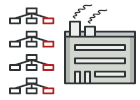
C# 抽象工厂模式讲解和代码示例
抽象工厂是一种创建型设计模式, 它能创建一系列相关的对象, 而无需指定其具体类。
抽象工厂定义了用于创建不同产品的接口, 但将实际的创建工作留给了具体工厂类。 每个工厂类型都对应一个特定的产品变体。
在创建产品时, 客户端代码调用的是工厂对象的构建方法, 而不是直接调用构造函数 ( new操作符)。 由于一个工厂对应一种产品变体, 因此它创建的所有产品都可相互兼容。
客户端代码仅通过其抽象接口与工厂和产品进行交互。 该接口允许同一客户端代码与不同产品进行交互。 你只需创建一个具体工厂类并将其传递给客户端代码即可。
如果你不清楚工厂、 工厂方法和抽象工厂模式之间的区别, 请参阅工厂模式比较。
复杂度:
流行度:
使用示例: 抽象工厂模式在 C# 代码中很常见。 许多框架和程序库会将它作为扩展和自定义其标准组件的一种方式。
识别方法: 我们可以通过方法来识别该模式——其会返回一个工厂对象。 接下来, 工厂将被用于创建特定的子组件。
概念示例
本例说明了抽象工厂设计模式的结构并重点回答了下面的问题:
- 它由哪些类组成?
- 这些类扮演了哪些角色?
- 模式中的各个元素会以何种方式相互关联?
Program.cs: 概念示例
using System;
namespace RefactoringGuru.DesignPatterns.AbstractFactory.Conceptual
{
// The Abstract Factory interface declares a set of methods that return
// different abstract products. These products are called a family and are
// related by a high-level theme or concept. Products of one family are
// usually able to collaborate among themselves. A family of products may
// have several variants, but the products of one variant are incompatible
// with products of another.
public interface IAbstractFactory
{
IAbstractProductA CreateProductA();
IAbstractProductB CreateProductB();
}
// Concrete Factories produce a family of products that belong to a single
// variant. The factory guarantees that resulting products are compatible.
// Note that signatures of the Concrete Factory's methods return an abstract
// product, while inside the method a concrete product is instantiated.
class ConcreteFactory1 : IAbstractFactory
{
public IAbstractProductA CreateProductA()
{
return new ConcreteProductA1();
}
public IAbstractProductB CreateProductB()
{
return new ConcreteProductB1();
}
}
// Each Concrete Factory has a corresponding product variant.
class ConcreteFactory2 : IAbstractFactory
{
public IAbstractProductA CreateProductA()
{
return new ConcreteProductA2();
}
public IAbstractProductB CreateProductB()
{
return new ConcreteProductB2();
}
}
// Each distinct product of a product family should have a base interface.
// All variants of the product must implement this interface.
public interface IAbstractProductA
{
string UsefulFunctionA();
}
// Concrete Products are created by corresponding Concrete Factories.
class ConcreteProductA1 : IAbstractProductA
{
public string UsefulFunctionA()
{
return "The result of the product A1.";
}
}
class ConcreteProductA2 : IAbstractProductA
{
public string UsefulFunctionA()
{
return "The result of the product A2.";
}
}
// Here's the the base interface of another product. All products can
// interact with each other, but proper interaction is possible only between
// products of the same concrete variant.
public interface IAbstractProductB
{
// Product B is able to do its own thing...
string UsefulFunctionB();
// ...but it also can collaborate with the ProductA.
//
// The Abstract Factory makes sure that all products it creates are of
// the same variant and thus, compatible.
string AnotherUsefulFunctionB(IAbstractProductA collaborator);
}
// Concrete Products are created by corresponding Concrete Factories.
class ConcreteProductB1 : IAbstractProductB
{
public string UsefulFunctionB()
{
return "The result of the product B1.";
}
// The variant, Product B1, is only able to work correctly with the
// variant, Product A1. Nevertheless, it accepts any instance of
// AbstractProductA as an argument.
public string AnotherUsefulFunctionB(IAbstractProductA collaborator)
{
var result = collaborator.UsefulFunctionA();
return $"The result of the B1 collaborating with the ({result})";
}
}
class ConcreteProductB2 : IAbstractProductB
{
public string UsefulFunctionB()
{
return "The result of the product B2.";
}
// The variant, Product B2, is only able to work correctly with the
// variant, Product A2. Nevertheless, it accepts any instance of
// AbstractProductA as an argument.
public string AnotherUsefulFunctionB(IAbstractProductA collaborator)
{
var result = collaborator.UsefulFunctionA();
return $"The result of the B2 collaborating with the ({result})";
}
}
// The client code works with factories and products only through abstract
// types: AbstractFactory and AbstractProduct. This lets you pass any
// factory or product subclass to the client code without breaking it.
class Client
{
public void Main()
{
// The client code can work with any concrete factory class.
Console.WriteLine("Client: Testing client code with the first factory type...");
ClientMethod(new ConcreteFactory1());
Console.WriteLine();
Console.WriteLine("Client: Testing the same client code with the second factory type...");
ClientMethod(new ConcreteFactory2());
}
public void ClientMethod(IAbstractFactory factory)
{
var productA = factory.CreateProductA();
var productB = factory.CreateProductB();
Console.WriteLine(productB.UsefulFunctionB());
Console.WriteLine(productB.AnotherUsefulFunctionB(productA));
}
}
class Program
{
static void Main(string[] args)
{
new Client().Main();
}
}
}
Output.txt: 执行结果
Client: Testing client code with the first factory type...
The result of the product B1.
The result of the B1 collaborating with the (The result of the product A1.)
Client: Testing the same client code with the second factory type...
The result of the product B2.
The result of the B2 collaborating with the (The result of the product A2.)
 冬季促销!
冬季促销!
